header - In digital imaging, technical information packaged with an image file, which may be of use in displaying the image (e.g. length and width in pixels), identifying the image (e.g. name or source), or identifying the owner.
heartwood - The part of a tree trunk yielding the densest, hardest wood, located deep within the tree. The heartwood and the outer wood — or sapwood — dry out at different rates, so sculptors generally separate the two, using heartwood when working at a smaller scale, and sapwood when working at a larger scale. Also see hollow carving.
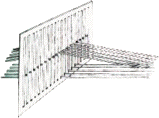
heddle - The device on a loom used for raising selected warps to create space through which the weft thread can easily pass. Illustrated here is a heddle of the slot-type.
Heian - A period in Japanese art history from 794-1185, often divided into the Early Heian (794-897) and the Late Heian (897-1185). The Heian was preceded by the Nara period (710-794) and followed by the Kamakura period (1185-1333).
Examples of Early Heian (794-897) art:

The priest Enchin (Japanese, 814-891), Early
Heian period, Letter, 31.2 x 56.0 cm, Tokyo National
Museum. Japanese authorities have designated this a "National
Treasure." See Buddhist
art.
Examples of Late Heian (897-1185) art:
![]()
Japan, Heian period, early 10th century CE,
Juichimen
Kannon (eleven-headed Kannon), solid woodblock construction
with traces of polychrome,
Worcester Art Museum, MA.

Japan, Heian period, end of the 10th century,
Jar with cover, Sanage Ware with ash
glaze, overall height 28.5, mouth
diameter 12.1, bottom diameter
17.4 cm, Tokyo National Museum.

Japan, Heian period, Head of a Guardian, second half of 11th
century, assembled woodblock construction with traces of polychrome and gilding,
Worcester Art Museum, MA.
Japan, Late Heian period, Fudo Myo-o, 12th century, wood with color and gold leaf, height 80 inches (203.2 cm), Metropolitan Museum of Art, NY. This statue of Fudo, whose name means "immovable," is a staunch guardian of the Buddhist faith, warding off enemies of the Buddha with his word of wisdom and binding evil forces with his lasso. A symbol of steadfastness in the face of temptation, Fudo is one of the most commonly depicted of the Esoteric Buddhist deities known as Myo-o, "King of Brightness." Here his youthful, chubby body and his skirt and scarf are modeled with the restrained, gentle curves typical of late Heian sculpture. Fudo's hair was once painted red and his flesh dark blue green.

Japan, Late Heian period, 12th century, Kujaku Myoo (Mahamayuri), 147.9 x 98.9
cm, Tokyo National Museum. Buddha sits upon both a lotus blossom
and a peacock. Japanese authorities have designated this a "National
Treasure."

height - The first dimension,
the measurement of the distance
from the level of the lowest point to the level of the highest
point of a shape or space.
The height of this black square is 115 pixels.
Quote:
Also see depth, direction, length, width, and vertical.
heighten - In drawing and painting, to raise the value of areas with white or a pale color in order to complete the rendition of forms. Along with its opposite — shading — an important aspect of chiaroscuro.
A related link:
Also see acrylic paints, autographic ink, body color, Chinese art, gouache, highlight, India ink, ink, Japanese art, luminosity, oil paint, perception, quill pen, seeing, sepia ink, tenebroso or tenebrism, wash, watercolor, and zinc white.
helium - A colorless, odorless, tasteless, non-explosive, and inert gaseous element. It is used in arc welding and gas-discharge lasers, as a component of artificial atmospheres, as a refrigerant, as a lifting gas for balloons. Tank sizes available include 221 cubic feet. Atomic symbol He, atomic number 2, atomic weight 4.0026, boiling point -268.9°C, density at 0°C 0.1785 gram per liter. (pr. hee'lee-m) Also see acetylene, argon, carbon dioxide, hydrogen, nitrogen, and oxygen.
helix - A three-dimensional spiral; a curve that lies on a cylinder or cone. Spirals — helixes and volutes — are among the ten classes of patterns. The chirality of a helix is the direction of its turning, or handedness. A right-handed helix turns as a screw does; a left-handed one turns in the opposite direction.
(pr. HEE-ləks)
Works in which this form is important:
![]()

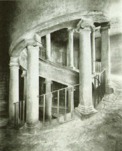
Donato Bramante (Italian, 1444-1514), architect,
Spiral Ramp, 1503, a right-handed helix, Vatican. A contemporary photograph of the ramp, and Bramante's drawing of it.

John Mortimer and John Samuel Hunt, makers
(English, in partnership 1839-1842), Caviar Pail, 1841, sterling
silver, Carnegie Museum of Art, Pittsburgh, PA. See helix.

Unknown carpenter, Spiral Staircase of Loretto Chapel, Santa Fé, NM, mid-1870s, various woods, 33 steps turning in a left-handed direction. The identity of the carpenter who constructed this helical staircase is one of the several mysteries about it. Another, local authorities say, is that no architect, engineer, or scientist has sastisfactorily explained what keeps this structure from collapsing. The carpenter worked alone, using woods which could not be obtained locally, and neither nails nor adhesives.

Frank Lloyd Wright (American, 1867-1959),
Solomon R. Guggenheim Museum, New York,
1959, an art museum constructed of concrete
as a helical ramping gallery
which expands as it coils around an unobstructed well of space, topped by a flat-ribbed
glass dome. This building
evoked for Wright "the quiet unbroken wave."
Man Ray (American, 1890-1977), Return to Reason, 1921, oil on canvas, 14 5/8 x 9 7/8 inches, Minneapolis Institute of Arts. See Dada.

A spiral staircase as seen from below, contemporary
photograph. A two-dimensional
image of a left-handed helix as seen from
this point of view becomes
another kind of spiral: a volute.
See worm's-eye view.
![]()

![]()
model of human DNA, a double-helix, always
turning in a right-handed direction. Dr. Francis Crick and Dr. James Watson discovered DNA's helical form — the most important biological discovery of the 20th century — in 1953. Francis Crick's first pencil sketches of the double-helix are in the collection of the Wellcome Library, London. (NY Times, Feb 20, 2005, p. 2)

Ben Winter (American, contemporary), manufactured by Zwirl Sales Inc., Danville, CA, Zwirl Football, 1985, polyurethane foam, height 9 inches (22.9 cm), diameter 5 1/2 inches (14 cm), Museum of Modern Art, NY. Marketers say it will, "help children learn to throw spirals without the fear of stinging catches." It turns in a left-handed direction.
[In May of 2005, I posed the question, "Is this the odd concession to left-handed people, or is there another reason the Zwirl Football has this direction?" Ben Winter read this, and responded, "I am left handed." - MRD]
![]()

![]()
A helix employed as the polychromed
surface of a sphere.
Quote:
Also see caduceus, coil, curve, horn, and structure.
hemisphere - Half of a sphere.
Also see concave, convex, dome, drape mold, and niche.
![]()

![]()
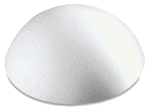
heptagon - A closed two-dimensional polygon bounded by seven straight-line segments.The formula with which to find an equilateral heptagon's area is 3.6339 times the length of one side squared.
Also see mathematics, radial, shape, and vertex.
heptahedron - A polyhedron having seven polygonal faces. The plural can be either heptahedrons or heptahedra.
Also see mathematics and vertex.
heritage - Something that one is born to: the status, conditions, character, and riches that belong to a person because that person is a member of a family, a social class, a particular society — i.e., a religious, ethnic, regional or national group. Whatever is inherited, passing from one generation to the next. The history, languages, way of life, the arts, and traditional culture that is passed from preceding generations. Synonyms include inheritance, birthright, legacy, and tradition.
(pr. Həh-rə-təj or HR-tj)
Also see antiquity, art history, civilization, custom, memory, posterity, posthumous, talent, and time.
herringbone perspective - A type of perspective in which the lines of projection converge not on a vanishing point, but on a vertical axis at the center of the picture, as in Roman painting.
Also see depth and orthogonals.
heterodox and heterodoxy - Contrary to or different from an acknowledged standard, a traditional form, or an established religion; unorthodox, unconventional. Or, holding unorthodox opinions or doctrines. Individuals often see other people's ideas as unconventional while regarding their own as beyond reproach. Contemporaries of Nicolaus Copernicus certainly considered him "not orthodox" (which in his day meant "not correct"), but they wouldn't have called him "heterodox" because that word didn't gain widespread use in English until about 100 years after he died. Although "orthodox" and "heterodox" are considered antonyms, they developed from the same root, the Greek "doxa," which means "opinion." "Heterodox" derives from a combination of "doxa" plus "heter-," a prefix meaning "other" or "different"; "orthodoxy" pairs "doxa" with "orth-," meaning "correct" or "straight."
(pr. HEH-tə-rə-DAHKS or HEH-truh-DAHKS)
Also see avant-garde, bohemianism, censor, contrast, creativity, eccentric, edge, iconoclasm, issue, political correctness, and transgressive art.
heuristic - Helping to discover or learn; serving to indicate,
point out, guide, or reveal. "Heuristic" can be either a noun or an adjective. A heuristic is anything — object or activity — that gets a person to think fruitfully about something in order to come up with a solution. Something is heuristic if it has this quality. It might be pushing a pencil, a crayon, or a brush; or looking through a stack of books, or taking a walk in a field (see Velcro ®). Each of these can be heuristic activities. Brainstorming is tremendously heuristic. Analyzing an image or model of a 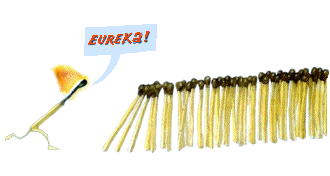 thing can help one to understand it. Exploring more and more ways to think about a thing gives a student ever-increasing understanding, as when an architect thinks about a site, its users' needs, floor plans, materials, engineering, styles, forms, and various aspects of potential solutions present themselves. This word comes from a Greek root meaning "to find," the same word from which we have "eureka": "I've GOT it!"
thing can help one to understand it. Exploring more and more ways to think about a thing gives a student ever-increasing understanding, as when an architect thinks about a site, its users' needs, floor plans, materials, engineering, styles, forms, and various aspects of potential solutions present themselves. This word comes from a Greek root meaning "to find," the same word from which we have "eureka": "I've GOT it!"
(pr. hyoo-RI-stək)
Also see cognitive, creativity, didactic, direction, inspiration, muse, and teacher.
hew - To make a shape as with an ax, chisel or other carving point. The past tense can be either hewed or hewn. Don't confuse hew with its homonym hue.
(pr. hyoo)

hexagon - A closed two-dimensional polygon bounded by six straight-line segments. The formula with which to find an equilateral hexagon's area is 2.5981 times the length of one side squared.
Also see mathematics, radial, shape, and vertex.

hexahedron - A polyhedron having six quadrilateral faces. A cube is an equilateral hexahedron, as well as being a prismatoid. The regular hexahedron is one of the five Platonic solids (along with the tetrahedron, octahedron, dodecahedron, and icosahedron). The plural form can be either hexahedrons or hexahedra.
Also see mathematics, polygon, and vertex.
hexaptych - See polyptych.
hiding - The hiding power of a pigment refers to its opacity — its capacity to cover colors and materials (support) underneath in order to obscure them completely.
Also see coat, surface, and white lead.
hieratic - Representing the sizes of things according to their importance, rather than how they would objectively appear in space. Hieratic compositions are often seen in the art of various ancient civilizations and primitive peoples, as well as during Europe's Middle Ages, and in the art of children at certain stages of artistic development. May also refer to things priestly, secerdotal.
(pr. HIGH-r-A-tək)
Examples of hieratic art:
Egypt, probably from Abydos, Stela of Mentuwoser, c. 1955 BCE, Dynasty 12, reign of Senwosret I, year 17, Middle Kingdom, painted limestone, 19 5/8 x 41 inches (49.8 x 104.1 cm), Metropolitan Museum of Art, NY. See Egyptian art.

Eastern Tibet, Portrait of Jnanatapa surrounded by lamas and
mahasiddhas, 14th century, distemper
on cloth, 27 x 21 1/2 inches (68.6 x 54.6 cm), Metropolitan Museum
of Art, NY.

Jan van Eyck and Workshop Assistant (Netherlandish,
active by 1422, died 1441), The Crucifixion and the Last Judgment,
c. 1430, oil on canvas,
transferred from wood, each 22 1/4
x 7 2/3 inches (56.5 x 19.7 cm), Metropolitan Museum of Art,
NY. (On the Met's page, you can enlarge any detail.) In the picture
on the left in this diptych,
the artist has set the crucifixion event against a distant landscape,
engaging various means to achieve an illusion of depth. In contrast,
he has organized the "Last Judgment" hieratically in
three tiers, and has manipulated the scale of the figures to
indicate their relative importance.
Also, the priestly supernaturalism disparaging matter and material values that prevailed throughout the Christian Middle Ages, especially in Orthodox Byzantiium.
Also see isocephaly, Mesopotamian art, and scale.
high art - Fine art, also known as beaux-arts, art that is of universal transcendence, having withstood the test of time and representing the epitome of artistic achievement, as opposed to low art, which is also known as mass culture. Until recently, a distinction was typically made between high and low art. Traditionally, high art consists of the meticulous expression in fine materials of refined or noble sentiment, appreciation of the former depending on such things as intelligence, social standing, educated taste, and a willingness to be challenged. Low art is the shoddy manufacturing in inferior materials of superficial kitsch, simply catering to popular taste, unreflective acceptance of realism, and a certain "couch potato" mentality. Although many earlier artists took inspiration from popular and folk art, the most systematic approaches towards blurring the differences between high and low art were taken by Cubism, Dada and Surrealism. Pop Art further weakened the distinction, and artists as various as Jean-Michel Basquiat (American, 1960-1988), Jeff Koons (American, 1955-) and the Guerrilla Girls (American), influenced strongly by the different branches of postmodern thought, have dealt it the further blows. It is not surprising, given for example that the song O Superman by performance artist Laurie Anderson (American, 1947-) reached the top ten of the pop charts in the U.S. and England, that video and camera artist William Wegman (American, contemporary) has appeared on television's The Tonight Show to promote a book of photographs, and that both have done segments on Saturday Night Live. In spite of this, one still wonders if the distinction still exists, albeit in a slightly different form. Few would seriously argue that the droves who follow televised wrestling matches and afternoon soap operas have any genuine interest in contemporary art. It is even less likely that the millions who read supermarket tabloids or romance novels would ever choose to read advanced art criticism.
highlight - The area on any surface which reflects the most light. Highlights and shadows are important to the achievement of chiaroscuro. Also, to direct attention or to emphasize through use of color.
Examples:
Michelangelo (born Michelangiolo Buonarroti)
(Italian, 1475-1564), the left eye of David, 1501-04, marble,
entire statue 17 feet high, Galleria dell'Accademia, Florence.
The pupil was carved not
to represent its form,
but to
 represent
its values. The sculptor has retained
a bit of marble inside the pupil in order to create a highlight.
A
represent
its values. The sculptor has retained
a bit of marble inside the pupil in order to create a highlight.
A detail of David's head,
and a second one. See colossal,
detail, Renaissance, and sculpture.
Stanford Computer Graphics Laboratory, Los Angeles, CA, has recently produced ultra-high-resolution digital images of Michelangelo's David and St. Matthew sculptures.

In this digital
image, a teapot is illuminated by only one small source of
light. Because the space is
so dark overall, the highlights on this simulated
object are critical to the
viewer's perception
of both its shape and its form.
Also see heighten.
himation - A rectangular woolen or linen cloak or mantle worn by men and women of ancient Greece. The himation was worn over a tunic and draped in various ways.
(pr. high-MAT-ə-un)
The plural form is himatia.
An example:

Greece, probably Boeotian, Standing draped female, Tanagra,
late 4th-early 3rd century BCE,
Classical, terra cotta, height
6 7/16 inches (16.4 cm), Metropolitan Museum of Art, NY.
Also see chiton, costume, fibula, mantle, peplos, and Tanagra.
historiated - Capital letters ornamented with representation, such as plants, animals, or human figures, that has a narrative — as distinct from a purely decorative — function. Historiated initial letters were a popular form of manuscript decoration in the Middle Ages.
A historiated letter might be considered a kind of factotum, any oversized ornamental capital letter used in printing.
Examples of historiated works:
Luristan (Western Iran), 8th - 7th century BCE, Horse Bit, bronze, height 19 cm, Louvre.
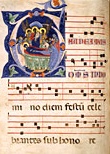
![]()
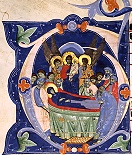
Gerona Bible Master, Bologna, Italy, Letter
"G" Historiated with the Death of the Virgin,
opening the Latin text
(or lyric) opening with "Gaudeamus," meaning "Let
us rejoice," in the Gradual, Proper and Common of Saints
(folio 84 verso
in Manuscript 526), c. 1285,
tempera on vellum,
one of 290 folios, 51.5 x
35.5 cm (20 1/4 x 14 inches), Musei Civici d'Arte Antica, Bologna.
This illumination
is painted in late Byzantine style.
Black marks arranged on the horizontal
lines (or "staff")
displayed on this page exemplify
the system of musical notation
used in Italy during much of the Middle
Ages.
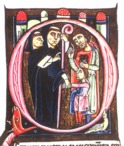
French, Historiated letter "O", from
a manuscript on vellum, 13th century, Library of Troyes, France.
The figures in this
historiated letter depict a boy who is accompanied by his father, and is being
inducted as a novice into monastic life, much as the artist who
drew this picture had entered his monastary years before. See
monasticism.
Also see calligraphy, illumination, majuscule, and zoomorphic.
historicity - The state or fact of actually having existed in history. The characteristic of an object ![]() having historical authenticity.
having historical authenticity.

![]()
Memorabilia associated with different people and events commands varying sorts of interest. Similarly, the power of even the most historic objects is relative. In December of 2007, Sotheby's sold a copy of Magna Carta, one of seventeen extant from 13th century England. Actually a copy of a copy, it was signed by King Edward I eighty-two years after King John signed the original Magna Carta in 1215, and yet this document's historicity is so compelling, the highest bidder paid $21,321,000 — the most ever paid for a page of text. If you click on the link to a larger view of it, you can print a copy of this copy of a copy. What will be that print's historicity? What could make its historicity compelling thousands of years in the future?
Quote
(pr. HIS-tə-RI-sə-tee)
Also see art history, collectible, counterfeit, description, forgery, material culture, memory, posterity, posthumous, provenance, quality, realia, replica, reproduction, seal, simulacrum, souvenir, and time.
https://inform.quest/_art